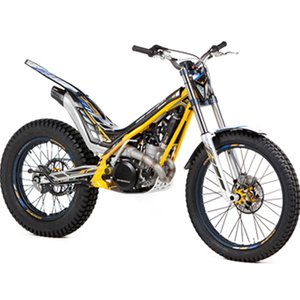Sherco Trials 1.25 (1999-2014): A Timeless Dance Partner for Technical Terrain
Introduction
The Sherco Trials 1.25 represents a fascinating era in trial motorcycle history – a 15-year production run (1999-2014) that refined the art of balance, precision, and lightweight agility. Designed for riders who treat rocky inclines, log piles, and riverbeds as their playground, this French-engineered machine isn’t about speed records or highway comfort. It’s about conquering impossible obstacles with finesse. After spending hours throwing this bike at artificial trial sections and natural terrain, one thing becomes clear: the 1.25 isn’t just a tool; it’s an extension of the rider’s instincts.
Design & Ergonomics: Minimalism with Purpose
Weighing between 67-69.5 kg (147.7-153.2 lbs) across generations, the Sherco 1.25 feels shockingly light when you first lift it off the stand. The slim chromoly frame (Deltabox in early models, tubular triangulated later) creates a narrow waist that lets your knees grip effortlessly. Seat heights varied slightly over the years – from 510mm (20.1") in 2005 to 645mm (25.4") in 2011 models – but the philosophy remained: low center of gravity for stability during slow-speed pivots.
Standing on the pegs (the only way to ride trials), the bars fall naturally to hand. Sherco’s focus on centralized mass is evident – flicking the bike sideways mid-obstacle requires minimal effort. The 2.3-3L (0.61-0.79 gal) fuel tank seems comically small until you realize most trial events rarely exceed 30km (18.6 miles). Every component screams purpose: no mirrors, no passenger pegs, just a raw interface between rider and terrain.
Engine Performance: Two-Stroke Theatre
The liquid-cooled 124.7-124.8cc two-stroke single (56x50.6mm bore/stroke) is a character actor. With a Leonelli electronic ignition and Dell’Orto PHBL26BS carb (later models), it delivers a crisp, linear powerband. Unlike motocross two-strokes that demand constant clutch work, the 1.25’s power delivery is almost diplomatic – enough torque to tractor up muddy banks from 2,500 RPM, yet forgiving when you whiskey-throttle over a surprise ledge.
The 5-speed gearbox (ratios unchanged throughout production) is a trials specialist’s dream. First gear is so low you could climb a tree, while fifth still allows 65-70 km/h (40-43 mph) transfers between sections. The hydraulic clutch (multidisc in oil bath post-2007) offers buttery modulation – critical when balancing on rear wheel pivots.
What’s fascinating is how Sherco avoided the four-stroke trend. This two-stroke’s 14:1 compression ratio and Nikasil-coated cylinder (2011+) ensure reliability, while the signature “ring-ding” soundtrack becomes a metronome for your riding rhythm.
Chassis & Suspension: Geometry Matters
Frame revisions tell a story. Early Deltabox frames (2005) prioritized rigidity, while 2009+ models adopted triangulated chrome-moly designs for better flex characteristics. The 2011 ST model’s geometry tweaks (1322mm/52" wheelbase) and repositioned balance point make it feel like the bike rotates around your hips during front-wheel hooks.
Suspension evolved notably:
- Front: Paioli 33mm forks (2005) provided 170mm (6.7") travel, while 2011’s Ceriani 38mm units increased to 185mm (7.3"). The latter’s adjustability lets you dial in stiffness for rocky descents vs. soft landings.
- Rear: Boge shocks (early) handled basic damping, but Olle adjustable units (2011+) transformed rear traction. With 175mm (6.9") wheel travel and progressive linkage, the rear tire stays planted even during awkward camber transitions.
Ground clearance fluctuated between 275-325mm (10.8-12.8") – enough to straddle boulders without dragging frame rails.
Handling Characteristics: Where Physics Take a Backseat
Riding the Sherco 1.25 is like having a cheat code for gravity. The combination of ultra-short wheelbase (1320-1327mm/52-52.2") and 68kg (149.9 lbs) dry weight makes direction changes laughably easy. Throw it into a tight turn, and the Michelin tires (21" front/18" rear on Morad rims) dig in with tenacious grip.
Standout features:
- Brakes: Single discs (145mm/5.7") front/rear offer progressive bite. Less aggressive than motocross setups, which prevents accidental lockups during delicate maneuvers.
- Footpegs: Wide serrated platforms let you shift weight dramatically without slipping – crucial for rear-wheel pivots.
- Exhaust: The low-slung steel/aluminum system (2011+) tucks neatly, avoiding snags on rocks.
Competition: Sherco vs. The Trial Titans
In the 125cc trial class, three names dominated:
1. GasGas TXT 125: Lighter at 64kg (141 lbs), but less stable on steep descents. GasGas’s V-force reed system gave sharper throttle response, yet Sherco’s hydraulic clutch felt more precise during prolonged sections.
2. Beta Evo 125: Beta’s 4T version appealed to emission-conscious riders, but the 2-stroke Evo couldn’t match Sherco’s low-RPM torque. Beta’s Sachs suspension was plusher, though.
3. Montesa Cota 4RT125: Honda’s four-stroke Montesa offered fuel injection and quieter operation, but at 74kg (163 lbs), it lacked Sherco’s flickability.
Sherco’s edge came from balance – enough power to challenge experts, yet forgiving enough for novices. Post-2009 frame updates also gave it a handling advantage over rivals stuck with older geometries.
Maintenance: Keeping the 1.25 in Fighting Shape
As MOTOPARTS.store’s trial specialist, here’s my maintenance cheat sheet:
Engine:
- Pre-Mix: 2% oil (98 octane fuel). Use synthetic trials-specific oils like Motul Trial 2T for cleaner combustion.
- Top End: Rebuild every 80-100 competition hours. Wiesco piston kits (available at MOTOPARTS) drop right in.
- Cooling: Check radiator fins for mud blockage. Upgrade to silicone hoses (Samco Sport) for durability.
Suspension:
- Forks: Change oil annually (5W viscosity). Paioli/Ceriani seal kits prevent leaks.
- Shock Linkage: Grease bearings every 40 hours. Allballs Racing bearing kits simplify rebuilds.
Electrics:
- Leonelli Ignition: Keep connections dielectric-greased. Swap plug (BR8ES) every 15 hours.
Extras:
- Skid Plates: Polisport guards protect frame rails.
- Brake Levers: Zeta adjustable levers improve modulation.
Conclusion: Why It Still Matters
The Sherco Trials 1.25 isn’t just a relic; it’s a benchmark. Whether you’re hunting for a first trial bike or a veteran wanting a pure ride, its blend of weight distribution, tractable power, and agile chassis remains relevant. Parts support is stellar too – from OEM to upgrades like Domino grips or JT sprockets available here at MOTOPARTS.store.
This bike rewards skill but doesn’t punish inexperience. After a day of failed climbs and triumphant clears, you’ll understand why Sherco kept this formula alive for 15 years – some dances don’t need new steps.


















